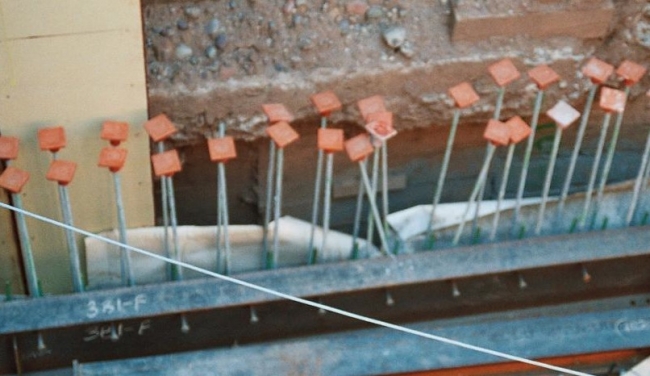Rebar Inspection
by Nick Gromicko, CMI®
Concrete-encased, steel reinforcement bars, also known as reinforcing bar or "rebar," are grooved steel bars used in reinforced concrete and other masonry structures.

Compared with its compressive strength (forces that act to shorten), concrete is relatively weak in tension (forces that act to lengthen or expand) and will crack under relatively low tensile loads, which is why reinforcement must be added.
Rebar is available in the United States in sizes from 3/8-inch (#3) to 2¼-inches (#18). The most common sizes used in residential and light commercial construction are #3 through #8, which represent diameters in increments of eighths of an inch.
Rebar is typically made from steel because it has a similar coefficient of thermal expansion to that of concrete, which minimizes stress on the structure in response to changing temperatures. Ridges are added to the bar for enhanced mechanical anchoring into the concrete. In order for the mechanical anchorage to be effective, the rebar must be completely surrounded by concrete. Rebar that does not have sufficient concrete cover. as well as rebar that is placed in poorly vibrated concrete, will result in a reduction of its load-carrying capacity.
Impalement Hazards
Rebar poses a common safety hazard on construction sites, where workers can be easily impaled if they fall onto its sharp ends. Even brushing past rebar, which is often rusty, can lacerate and infect exposed skin. In 2002, a young Saskatchewan construction worker died when he fell from a foundation wall and onto unguarded steel rebar. To prevent against these hazards, practice the following safety measures:
- Barricade hazardous areas and prohibit workers from entering them until work is ready to proceed safely.
- Make sure that work areas above protruding rebar are equipped with guardrails and fall-arrest systems.
- Cap the ends of protruding rebar to spread the force generated by a falling body through a large enough area that actual impalement should not occur. Use only rebar caps designed for this purpose, such as those that contain steel reinforcement or wood 2x4s, as the standard, plastic “mushroom” caps are designed for scratch-protection only.
- Cap all rebar that's protruding horizontally to prevent scrapes, cuts and eye injuries.
- Bend the ends of protruding steel rebar so that the exposed ends are no longer upright. Also, make sure you have a firm footing before manually bending the rebar, and do not place your entire weight on the bar, as you may injure yourself if the bar slips or breaks.
- Train workers and supervisors about the dangers of rebar impalement.
- Wear heavy gloves and other personal protective equipment when handling rebar because its typically sharp ends can cause lacerations and puncture wounds.
- Use mechanical hoists or lifts to handle heavy bundles of rebar.
- When manually transporting rebar, make sure you have a clear path so that their sharp ends don't accidentally injure others.
Used as Grounding Electrodes
Rebar may be used as grounding electrodes in the following ways:
- as concrete-encased electrodes (Ufer grounds). This electrical grounding technique was invented during World War II in Arizona, and is commonly called “Ufer” after its creator, Herbert G. Ufer. Wires are attached to the rebar within a structure so that an electrical charge will enter the encased concrete and harmlessly dissipate into the underlying earth. This method is more common in newer residential construction and requires a metal frame; and
- as ground rods. Rebar is sometimes used as a grounding electrode in place of standard galvanized steel or iron rods designed for that purpose. Rebar will not make an ideal ground rod because it readily rusts, which will increase electrical resistance. Also, as rebar can be easily bent, it might be difficult to hammer an 8-foot length of rod deep enough into the ground for it to safely dissipate an electrical charge.
In summary, rebar is widely used in concrete structures and as grounding electrodes, although it can be a serious safety hazard if not handled with caution and common sense.

